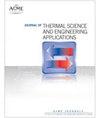利用神经网络进行热传导分析
IF 1.4
4区 工程技术
Q3 ENGINEERING, MECHANICAL
引用次数: 0
摘要
预测通过固体和流体的传热机制是一个持续需求的研究课题,因为在许多工程和工业应用中,精确而快速的温度计算至关重要。本文介绍了一种基于深度学习的新型计算框架,可在 0.04 秒内即时计算整个模拟周期内固体和流体温度变化的新模型。传热方程等偏微分方程可以根据已知的边界条件点在任意点直接求解,而无需进行域离散化。因此,只需使用最少的计算资源,就能实现即时、精确的温度计算。所提出的深度学习模型可应用于许多工程应用和产品,如在线热监测或数字孪生技术。通过比较深度学习模型获得的温度值和实验温度测量值,新模型得到了很好的验证。此外,还与其他数值模型进行了计算成本比较,以证明所提出的深度学习模型的高效性。本文章由计算机程序翻译,如有差异,请以英文原文为准。
Using neural networks for thermal analysis of heat conduction
Predicting heat transfer mechanisms through solids and fluids is a continuously demanding research topic since accurate and fast temperature calculation is crucial in many engineering and industrial applications. The paper presents a new model to calculate the temperature variation of solids and fluids instantly, in less than 0.04 s, for the whole simulation period based on a novel computational framework of deep learning. The partial differential equation, such as the heat transfer equation, can be solved directly at any point according to a well-known boundary condition point without the need for domain discretization. Therefore, instant and accurate temperature calculation is achieved with the minimum computational resources. The proposed deep learning model can be applied in many engineering applications and products by using it in online thermal monitoring or digital twin technology. The new model is well validated by comparing the temperature values obtained from the deep learning model with the experimental temperature measurements. Moreover, a computational cost comparison with other numerical models is conducted to prove the high efficiency of the proposed deep learning model, where MATLAB is utilized to develop the required codes.
求助全文
通过发布文献求助,成功后即可免费获取论文全文。
去求助
来源期刊

Journal of Thermal Science and Engineering Applications
THERMODYNAMICSENGINEERING, MECHANICAL -ENGINEERING, MECHANICAL
CiteScore
3.60
自引率
9.50%
发文量
120
期刊介绍:
Applications in: Aerospace systems; Gas turbines; Biotechnology; Defense systems; Electronic and photonic equipment; Energy systems; Manufacturing; Refrigeration and air conditioning; Homeland security systems; Micro- and nanoscale devices; Petrochemical processing; Medical systems; Energy efficiency; Sustainability; Solar systems; Combustion systems
 求助内容:
求助内容: 应助结果提醒方式:
应助结果提醒方式:


